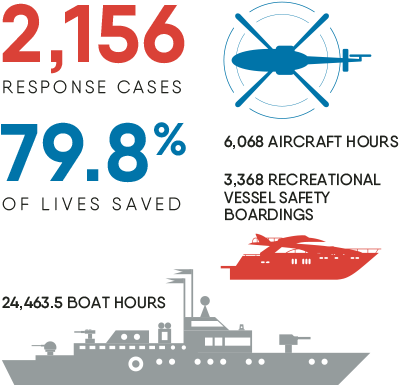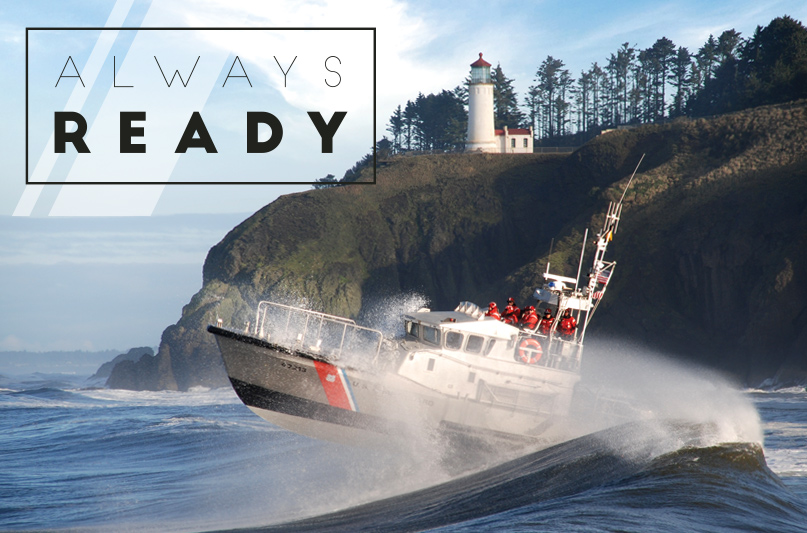
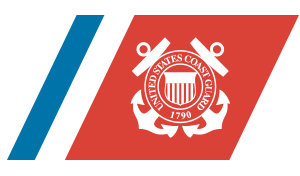 To understand what members of the U.S. Coast Guard (USCG) are made of, we must start with the story of Signalman 1st Class Douglas Albert Munro of Cle Elum, Washington. The date: September 27, 1942. The place: Guadalcanal, Solomon Islands. Nearly 500 Marines are trapped by enemy Japanese forces at Point Cruz. Munro, as the petty officer in charge, leads a group of 24 Higgins boats in the evacuation of the Marines.
To understand what members of the U.S. Coast Guard (USCG) are made of, we must start with the story of Signalman 1st Class Douglas Albert Munro of Cle Elum, Washington. The date: September 27, 1942. The place: Guadalcanal, Solomon Islands. Nearly 500 Marines are trapped by enemy Japanese forces at Point Cruz. Munro, as the petty officer in charge, leads a group of 24 Higgins boats in the evacuation of the Marines.
Munro leads five of his small craft toward the shore, then signals the others to land. The boats are strafed by enemy machine guns. To draw the enemy’s fire and protect the boats loaded with evacuees, Munro places his craft with its two small guns as a shield between the beachhead and enemy forces.
The evacuation was nearly completed when Munro was mortally wounded by enemy bullets. As he died, he sought confirmation that all of the Marines had been evacuated. His last words, according to a shipmate, “Did they get off?”
President Franklin D. Roosevelt presented the Medal of Honor to the signalman’s parents on May 24, 1943 in a White House ceremony. To this date, Munro is the only member of the USCG to receive the Medal of Honor.
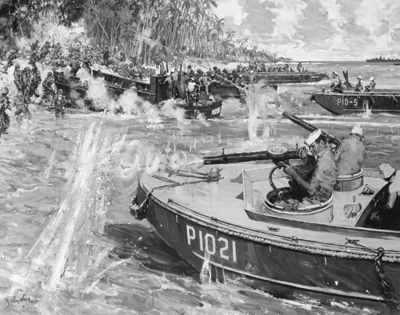
Munro was “a true shipmate in every sense of the word,” USCG Commandant Admiral Bob Papp wrote on September 27, 2012 in All Hands, the Coast Guard’s official blog. “Munro’s selfless service fully embodies the Coast Guard ethos. Because while we work together as a team to accomplish our mission, each Coast Guardsman is an individual who is capable–and expected–to make a difference.”
And indeed they do. As you read this, USCG personnel in the Pacific Northwest and beyond are clearing navigable paths in icy Arctic waters, enforcing laws related to fisheries and environmental protection, maintaining aids to navigation, performing search-and-rescues, intercepting drug smugglers, patrolling our ocean and inland coasts, and participating in defense missions abroad.
Other than the Coast Guard’s evacuation of Marines at Guadalcanal, few stories exemplify the risks the Coast Guard will take to save lives more than the February 18, 1952 rescue of 32 crew members on a tanker that broke in two in a nor’easter off Cape Cod, Massachusetts. Motor Lifeboat CG 36500’s Boatswain’s Mate 1st Class Bernard Webber negotiated a treacherous shoal and a powerful storm, which shattered the lifeboat’s windshield and tore its compass from its mounts. He reached the stricken ship’s stern and, carefully timing the sea swells, motored the lifeboat back and forth with the waves while the ship’s crew lowered themselves down the side with a Jacob’s ladder. The rescue has been cited as one of the greatest in the history of the USCG and was the subject of a movie, The Finest Hours, starring Chris Pine.
The Coast Guard’s presence in the Pacific Northwest is both historic and strategically important. USCG Air Station Port Angeles was commissioned on June 1, 1935, the first permanent Coast Guard air station on the Pacific Coast. The Coast Guard’s presence in Port Angeles dates to Aug. 1, 1862, with the arrival of the Shubrick, the first cutter to be homeported on the Olympic Peninsula.
Coast Guard Station Cape Disappointment is the oldest search-and-rescue station in the 13th Coast Guard District and is home to the Coast Guard’s National Motor Lifeboat School. The station’s area of responsibility stretches from Ocean Park on the Washington coast to Tillamook Head on the Oregon coast. The station has nine search and rescue boats, including a 52′ motor lifeboat, two 47′ motor lifeboats, and two 29′ response boats. The 52′ and 47′ vessels are designed for operations in heavy surf conditions and can re-right themselves if rolled over by breaking swells.
The USCGC Healy, homeported in Seattle, is the Coast Guard’s largest vessel and the U.S.’s largest and most technologically advanced icebreaker.
“We’re often associated with search and rescue, but we have a lot of missions,” said Lt. (j.g.) Kelsey Smith, a rescue-helicopter pilot stationed at USCG Air Station Port Angeles. “Most people don’t realize the extent of what we do.”
Smith, a 2015 Coast Guard Academy graduate, was on his first day on the job at Port Angeles when the report came in. A small boat overturned off Vashon Island and two people were in the water. It was a dark, cold January night. The water temperature was 47 degrees Fahrenheit, and the distance to the boat was 56 nautical miles. Within 30 minutes, Smith and his crew in their MH-65 Dolphin helicopter were on the scene.
Personnel from USCG Station Seattle had retrieved one boater; Smith and his crew located the other. The Dolphin helicopter hovered at 30’ to 40’, a swimmer was lowered by cable to the water and other the boater was retrieved. Unfortunately, one boater died from hypothermia, but one life was saved.
“This area, you get the best and the worst in weather conditions,” Smith said. “Especially in the winter—low ceiling, freezing temperatures, fog. But we go out when no one else can go. If someone’s life is on the line, we can take more risks.”
That ability and willingness to take risks is due in equal measure to well-maintained equipment, training, courage, and the aforementioned USCG creed: “I serve the people of the United States. I will protect them. I will defend them. I will save them. I am their shield.”
The USCG is comprised of 40,992 active duty personnel, 7,000 reservists, and 8,577 full-time civilian employees, according to October 2018 statistics. The USCG is the world’s 12th largest naval force, with 243 coastal and ocean-going patrol ships, tenders, tugs, and icebreakers; 1,650 smaller boats; and an aviation division consisting of 201 helicopters and fixed-wing aircraft.
“The [U.S.] Coast Guard does more than search and rescue,” Shelley Kimball wrote in 2014 in All Hands. Her husband, Capt. Joe Kimball, is currently the Coast Guard’s chief of aviation forces.

“Yes, we are incredibly proud of the search and rescue missions and the lives saved,” Kimball wrote. USCG rescue personnel saved 3,443 lives in 2014 and 3,536 lives in 2015, according to a USCG report. “But we also want everyone to recognize the thousands and thousands of maritime inspections and boardings Coasties conducted to keep our waters safe. Add to that the drug interdictions – more than 166,000 pounds (75.219 metric tons) of cocaine was removed in 2012.” The amount of cocaine seized has increased significantly over the ensuing years to 223.8 metric tons in 2017, according to an independent performance audit.
The USCG is extending protection beyond the borders in partnership with the Royal Canadian Mounted Police (RCMP).
In Shiprider, known formally as Integrated Cross-border Maritime Law Enforcement Operations, USCG and RCMP vessels near the maritime boundary are crewed by specially trained personnel from each country who are authorized to enforce the law on both sides of the international boundary line.
Shiprider officers say the program provides an efficient means of securing both sides of the northern border without violating the sovereignty of either nation.
“U.S. Coast Guard boarding officers are designated under the RCMP Act as supernumerary special constables, and RCMP officers are designated under U.S. Customs authority as officers working with the U.S. Coast Guard,” USCG
Ensign Mark Magrano said in a video about Shiprider.
“So now we share authority and jurisdiction on both sides of the border—working under the RCMP’s lead if we’re in Canadian waters, and under the U.S. Coast Guard’s lead if we’re in United States waters.”
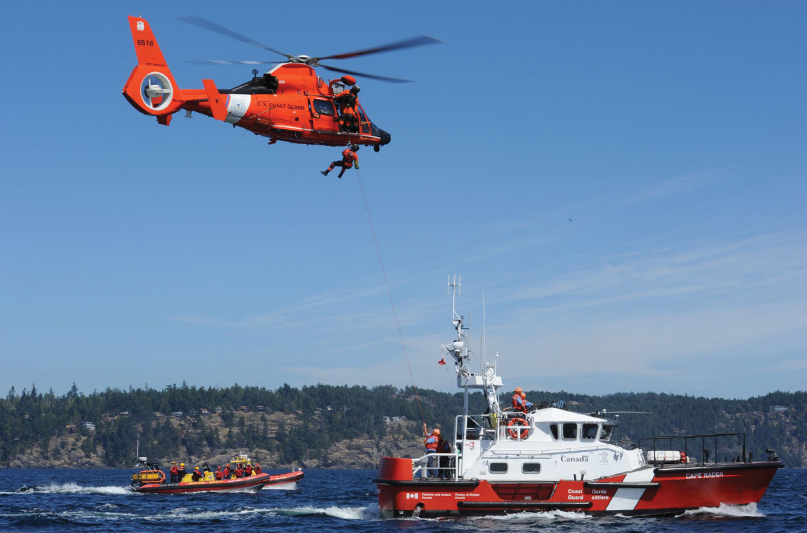
Since the Shiprider agreement was adopted in 2016 by the USCG and the 13th Coast Guard District (similar agreements exist between Canada and other USCG districts), officers from both nations have patrolled the Salish Sea boundary together, seizing smuggled drugs, stopping people entering either nation illegally, citing or arresting impaired boaters, and enforcing each nation’s environmental and fisheries laws.
In July 2018, Shiprider officers arrested a British Columbia man after 90 illegally caught crabs were found in coolers aboard his vessel. He was also found to be intoxicated.
“If we look at the coastline we’re working here [in the Salish Sea], criminals are not bound by the line in the water that we call the border,” Sgt. Jock Wadley of the RCMP Border Integrity Program said in a video about Shiprider.
“They can run the border at will, they can use the border to hide behind, whereas we as law enforcement agencies for each country are required to stop at the border. Without the Shiprider program, that’s what we would have to do — in effect, once someone crosses the border, we cease our activity. With the Shiprider program, we can follow it to its conclusion.”
USCG officers and enlisted personnel are bound in purpose to the nation they serve, and to each other. The ranks of the USCG is about the same size as the New York Police Department, so when one Coast Guard member suffers, “it’s felt throughout the entire service,” Lt. Smith said. “We’re known for taking care of our people. Everyone knows everyone.”
When my USCG father died in 1997, his ashes were spread at sea in a time-honored ceremony from a USCG cutter off the shoreline of Alameda, California. Dick Walker had entered the USCG there in 1951 at the age of 16 and served for a little more than two years. When his buddies were graduating from high school, he was an honorably discharged veteran with North Atlantic service under his belt and a National Defense Medal on his record.
Many served longer than he did. But 43 years later, the USCG still remembered him as a member of the family. Photographs of the ceremony showed enlisted personnel at attention, saluting, as his ashes were returned to the ocean he loved. A letter recounting the ceremony, written by the cutter’s commanding officer, referred to him as “Our brother.”
USCG communities are a big part of the support network too. “Not all military support programs include the Coast Guard … We are part of the Department of Homeland Security [and] some of the family support programs are only for the branches under the Department of Defense, so we get left out of those. (It’s a budget issue, not a preferential one),” Kimball blogged.
“We rely on, and we appreciate, community programs that support the Coast Guard. Our bases are smaller, and therefore we don’t necessarily have commissaries and exchanges like other services.” She wrote that a USCG member told her, “For communities to have programs in place for military members and their dependents, it’s really needed and appreciated.”
The Coast Guard Foundation, a nonprofit committed to the education and well-being of USCG personnel and their families, announced November 5 it has disbursed $220,000 to assist Coast Guard families affected by hurricanes Florence and Michael. The Coast Guard Foundation has helped more than 80 families to date with temporary living expenses, household goods and appliances, insurance deductibles, and home repairs. The foundation raised $1 million in 2017 to assist Coast Guard families affected by hurricanes in Texas, Florida and Puerto Rico, and by wildfires and mudslides in California.
“The men and women of the [U.S.] Coast Guard are unique in government agencies in that they are not only called upon to help those in need in times of devastation, but their families may also be among those affected by natural disasters,” foundation president Susan Ludwig said in an announcement of the assistance in the wake of Florence and Michael.
“We can think of no better way to help these dedicated professionals focus on the task at hand than by assisting their families at home.”After you set this magazine down, the USCG story will continue. A USCG lifeboat out of Cape Disappointment will be negotiating rough seas to get to someone in need. A USCG helicopter will race out to a ship at sea to airlift someone in medical distress. A USCG rescue diver will rappel into frigid waters to save someone’s life.
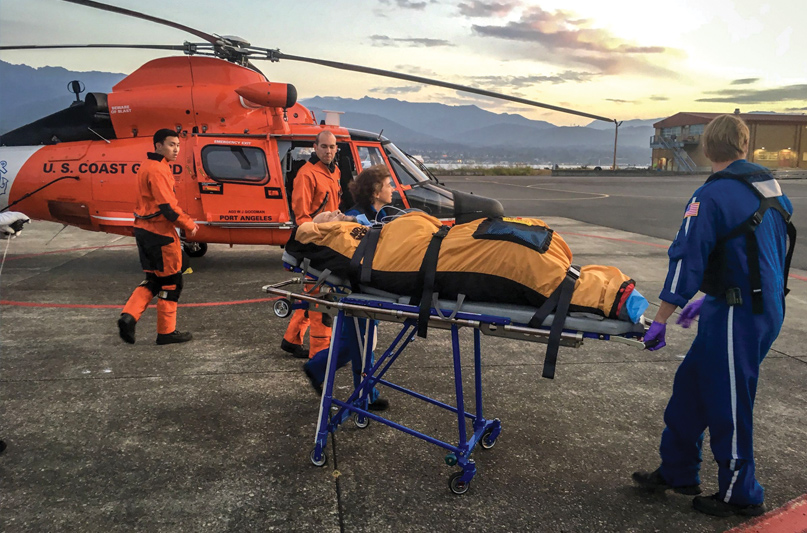
Smith, the MH-65 Dolphin co-pilot, said all hands try to live up to the Coast Guard ethos as exemplified by legends like Cle Elum’s Munro.
“You’re in the wrong business if you put yourself first,” Smith said. “There’s a reason we do this. When you get to pull someone out of the water, there’s no better feeling you can get than that.”
He added, “We love what we do.”



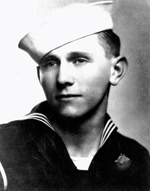 Signalman 1st Class Douglas A. Munro, USCG, posthumously received the Medal of Honor for his efforts to evacuate Marines on September 27, 1942 during the Battle of Guadalcanal. Munro was killed in action. President Franklin D. Roosevelt presented the Medal of Honor to the petty officer’s family in May 1943 at the White House, and over the ensuing years, three vessels were named in his honor: CGC Munro (WHEC-724), CGC Munro (WMSL-755), and USS Douglas A. Munro (DE-422).
Signalman 1st Class Douglas A. Munro, USCG, posthumously received the Medal of Honor for his efforts to evacuate Marines on September 27, 1942 during the Battle of Guadalcanal. Munro was killed in action. President Franklin D. Roosevelt presented the Medal of Honor to the petty officer’s family in May 1943 at the White House, and over the ensuing years, three vessels were named in his honor: CGC Munro (WHEC-724), CGC Munro (WMSL-755), and USS Douglas A. Munro (DE-422).